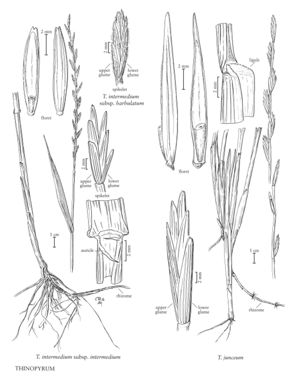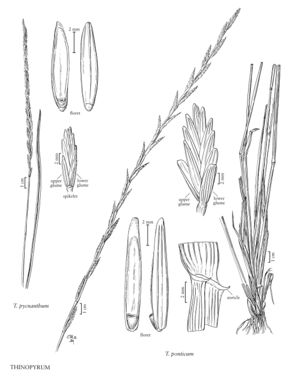Plants perennial; cespitose or not, sometimes rhizomatous. Culms 10-250 cm, usually erect. Sheaths open, glabrous or ciliate; auricles 0.2-1.8 mm or absent; ligules membranous; blades convolute or flat. Inflorescences terminal, distichous spikes, usually not disarticulating at maturity, with 1 spikelet at all or most nodes; internodes 5-30 mm. Spikelets 1-3 times the length of the middle internodes, solitary, appressed to ascending, often diamond-shaped in outline and arching outwards at maturity; disarticulation tardy, usually beneath the florets, sometimes in the rachises. Glumes rectangular to lanceolate, narrowing beyond midlength, stiff, indurate to coriaceous, glabrous or with hairs, keeled or rounded at the base, usually more strongly keeled distally than proximally, 4-9-veined, midveins usually scabrous distally, margins often hyaline, apices truncate to acute, sometimes mucronate, unawned, without lateral teeth; lemmas 5-veined, coriaceous, glabrous or with hairs, truncate, obtuse, or acute, sometimes mucronate or awned, awns to 3 cm; anthers 3, 2.5-12 mm. x = 7.
Distribution
Wash., N.H., Oreg., Ariz., N.Mex., Wyo., N.J., Iowa, Kans., Mont., N.Dak., Nebr., S.Dak., N.Y., Pa., Alta., B.C., N.B., N.S., Ont., Que., Sask., Yukon, R.I., Nev., Colo., Calif., Ill., Ga., Idaho, Maine, Mass., Tex., Utah, Mo., S.C.
Discussion
Thinopyrum includes approximately ten species, most of which are alkaline tolerant. It is native from the Mediterranean region to western Asia. Four species are established in the Flora region; only T. intermedium and T. ponticum are common. The genus is sometimes included in Elytrigia Desv. or Elymus.
Thinopyrum differs from the other Triticeae in its thick, stiff glumes and lemmas. These are several cells thick, even between the veins (Jarvie and Barkworth 1992b).
Selected References
Key
| 1 | Plants not rhizomatous; glumes truncate, midveins about equal in length and prominence to the lateral veins | Thinopyrum ponticum |
| 1 | Plants rhizomatous; glumes obliquely truncate or obtuse to acute, midveins usually slightly longer and more prominent than the lateral veins. | > 2 |
| 2 | Glumes 9-18 mm long | Thinopyrum pycnanthum |
| 2 | Glumes 4.5-8.5 mm long. | > 3 |
| 3 | Lemmas 7.5-10 mm long, glabrous or hairy; rachis internodes 7-12 mm long; plants widespread in the Flora region, particularly in the western United States | Thinopyrum intermedium |
| 3 | Lemmas 10-17 mm long, glabrous; rachis internodes 12-28 mm long; plants known only from a few coastal locations in the Flora region | Thinopyrum junceum |
"decumbent" is not a number."-3timesthelengthof" is not declared as a valid unit of measurement for this property.

